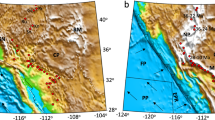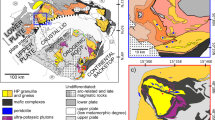Abstract
Metamorphic core complexes are domal uplifts of metamorphic and plutonic rocks bounded by shear zones that separate them from unmetamorphosed cover rocks1. Interpretations of how these features form are varied and controversial, and include models involving extension on low-angle normal faults2, plutonic intrusions3 and flexural rotation of initially high-angle normal faults4. The D'Entrecasteaux islands of Papua New Guinea are actively forming metamorphic core complexes located within a continental rift that laterally evolves to sea-floor spreading5. The continental rifting is recent (since ∼6 Myr ago)5, seismogenic6 and occurring at a rapid rate (∼25 mm yr-1)5. Here we present evidence—based on isostatic modelling, geological data and heat-flow measurements—that the D'Entrecasteaux core complexes accommodate extension through the vertical extrusion of ductile lower-crust material, driven by a crustal density inversion. Although buoyant extrusion is accentuated in this region by the geological structure present—which consists of dense ophiolite overlaying less-dense continental crust—this mechanism may be generally applicable to regions where thermal expansion lowers crustal density with depth.
This is a preview of subscription content, access via your institution
Access options
Subscribe to this journal
Receive 51 print issues and online access
$199.00 per year
only $3.90 per issue
Buy this article
- Purchase on Springer Link
- Instant access to full article PDF
Prices may be subject to local taxes which are calculated during checkout




Similar content being viewed by others
References
Coney, P. J. in Cordilleran Metamorphic Core Complexes (eds Crittenden, M. D., Coney, P. J. & Davis, G. H.) 7–31 (The Geological Society of America, Boulder, 1980).
Wernicke, B. Low-angle normal faults in the Basin and Range Province: nappe tectonics in an extending orogen. Nature 291, 645–648 (1981).
Lister, G. & Baldwin, S. Plutonism and the origin of metamorphic core complexes. Geology 21, 607–610 (1993).
Buck, W. R. Flexural rotation of normal faults. Tectonics 7, 959–973 (1988).
Taylor, B., Goodliffe, A. M. & Martínez, F. How continents break up: insights from Papua New Guinea. J. Geophys. Res. 104, 7497–7512 (1999).
Abers, G. A., Mutter, C. Z. & Fang, J. Shallow dips of normal faults during rapid extension: Earthquakes in the Woodlark-D'Entrecasteaux rift system, Papua New Guinea. J. Geophys. Res. 102, 15301–15318 (1997).
Rogerson, R., Hilyard, D., Francis, G. & Finlayson, E. The foreland thrust belt of Papua New Guinea. Proc. Pacif. Rim Congr. 87, 579–583 (1987).
Davies, H. L. & Warren, R. G. Origin of eclogite-bearing, domed, layered metamorphic complexes (“core complexes”) in the D'Entrecasteaux Islands, Papua New Guinea. Tectonics 7, 1–21 (1988).
Weissel, J. K. & Watts, A. B. Tectonic evolution of the Coral Sea basin. J. Geophys. Res. 84, 4572–4582 (1979).
Davies, H. L. Peridotite-gabbro-basalt complex in eastern Papua: An overthrust plate of oceanic mantle and crust. (Bulletin No. 128, Bureau of Mineral Resources, Geology and Geophysics, Canberra, 1971).
Davies, H. L., Symonds, P. A. & Ripper, I. D. Structure and evolution of the southern Solomon Sea region. BMR J. Aust. Geol. Geophys. 9, 49–68 (1984).
Taylor, B. Background and regional setting. Proc. ODP Init. Rep. [CD-ROM] (eds Taylor, B. et al.) 180, 1–20 (Ocean Drilling Program, Texas A & M Univ., College Station, 1999).
Ferris, A. et al. Active continental extension and metamorphic core complexes: A PASSCAL seismic deployment in the D'Entrecasteaux Islands, eastern Papua New Guinea. Eos 81, F881 (2000).
Baldwin, S. L., Lister, G. S., Hill, E. J., Foster, D. A. & McDougall, I. Thermochronologic constraints on the tectonic evolution of an active metamorphic core complex, D'Entrecasteaux Islands, Papua New Guinea. Tectonics 12, 611–628 (1993).
Hill, E. J., Baldwin, S. L. & Lister, G. S. Unroofing of active metamorphic core complexes in the D'Entrecasteaux Islands, Papua New Guinea. Geology 20, 907–910 (1992).
Fang, J. Styles and Distribution of Continental Extension Derived from the Rift Basins of Eastern Papua New Guinea. Thesis, Columbia Univ. (2000).
Davies, H. L. & Warren, R. G. Eclogites of the D'Entrecasteaux Islands. Contrib. Mineral. Petrol. 112, 463–474 (1992).
Finlayson, D. M., Drummond, B. J., Collins, C. D. N. & Connelly, J. B. in Volcanism in Australasia (ed. Johnson, R. W.) 259–274 (Elsevier, Amsterdam, 1976).
Shipboard Scientific Party. Leg 180 Summary. Init. Rep. ODP (eds Taylor, B., et al.) 1–77 (Ocean Drilling Program, Texas A & M Univ., College Station, 1999).
Baldwin, S. L., Monteleone, B., Hill, E. J., Ireland, T. R. & Fitzgerald, P. G. Continental extension in the western Woodlark Basin, Papua New Guinea. Eos 81, F1307 (2000).
Francis, G., Lock, J. & Okuda, Y. Seismic stratigraphy and structure of the area to the southeast of the Trobriand Platform. Geo-Mar. Lett. 7, 121–128 (1987).
Milsom, J. The gravity field of the Papuan Peninsula. Geol. Mijnb. 52, 13–20 (1973).
Sclater, J. G., Jones, E. J. W. & Miller, S. P. The relationship of heat flow, bottom topography and basement relief in Peake and Freen Deeps, northeast Atlantic. Tectonophysics 10, 283–300 (1970).
Langseth, M. G., Hobart, M. A. & Horai, K. Heat flow in the Bering Sea. J. Geophys. Res. 85, 3740–3750 (1980).
Taylor, B., Goodliffe, A., Martínez, F. & Hey, R. N. Continental rifting and initial seafloor spreading in the Woodlark basin. Nature 374, 534–537 (1995).
Royden, L. & Keen, C. E. Rifting processes and thermal evolution of the continental margin of eastern Canada determined from subsidence curves. Earth Planet. Sci. Lett. 51, 343–361 (1980).
Steckler, M. S. The Thermal and Mechanical Evolution of Atlantic-Type Continental Margins. Thesis, Columbia Univ. (1981).
Buck, W. R., Martínez, F., Steckler, M. S. & Cochran, J. R. Thermal consequences of lithospheric extension: Pure and simple. Tectonics 7, 213–234 (1988).
Seager, W. R. Low-angle gravity glide structures in the northern Virgin Mountains, Nevada and Arizona. Geol. Soc. Am. Bull. 81, 1517–1538 (1970).
Ollier, C. D. & Pain, C. F. Active rising surficial gneiss domes in Papua New Guinea. J. Geol. Soc. Aust. 27, 33–44 (1980).
Acknowledgements
We thank E. Davis for providing the heat flow probes used in this study; T. Lewis and A. Taylor for their help and expertise in acquiring and reducing heat flow measurements at sea; the Captain and crew of the RV Maurice Ewing for their efforts which led to a successful cruise; and R. Buck and S. Baldwin for comments and suggestions which improved the paper. This work was supported by the US National Science Foundation.
Author information
Authors and Affiliations
Corresponding author
Rights and permissions
About this article
Cite this article
Martinez, F., Goodliffe, A. & Taylor, B. Metamorphic core complex formation by density inversion and lower-crust extrusion. Nature 411, 930–934 (2001). https://doi.org/10.1038/35082042
Received:
Accepted:
Issue Date:
DOI: https://doi.org/10.1038/35082042
This article is cited by
-
Determining the key conditions for the formation of metamorphic core complexes by geodynamic modeling and insights into the destruction of North China Craton
Science China Earth Sciences (2016)
-
Pliocene eclogite exhumation at plate tectonic rates in eastern Papua New Guinea
Nature (2004)
-
Mantle compensation of active metamorphic core complexes at Woodlark rift in Papua New Guinea
Nature (2002)
Comments
By submitting a comment you agree to abide by our Terms and Community Guidelines. If you find something abusive or that does not comply with our terms or guidelines please flag it as inappropriate.



